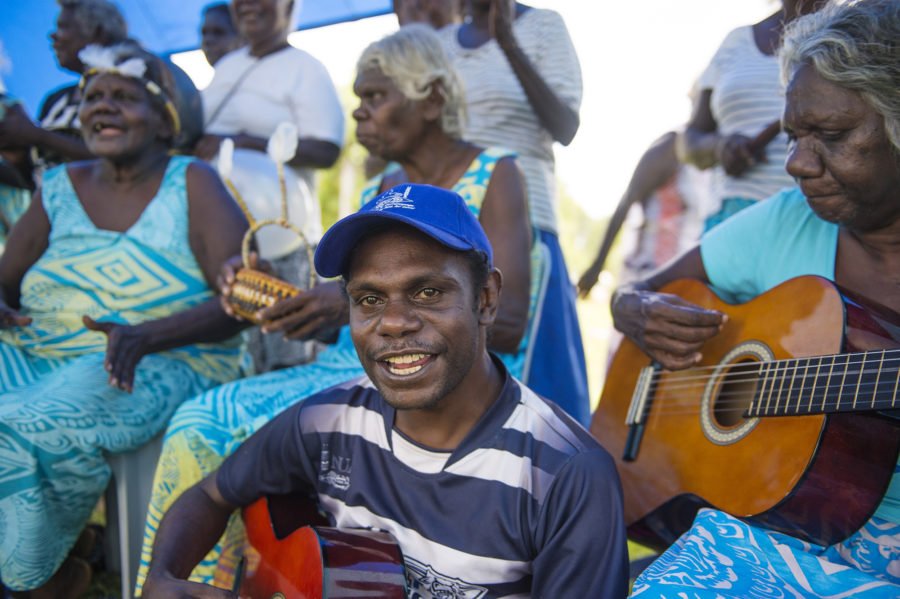Tiwi Islands: Where footy meets culture
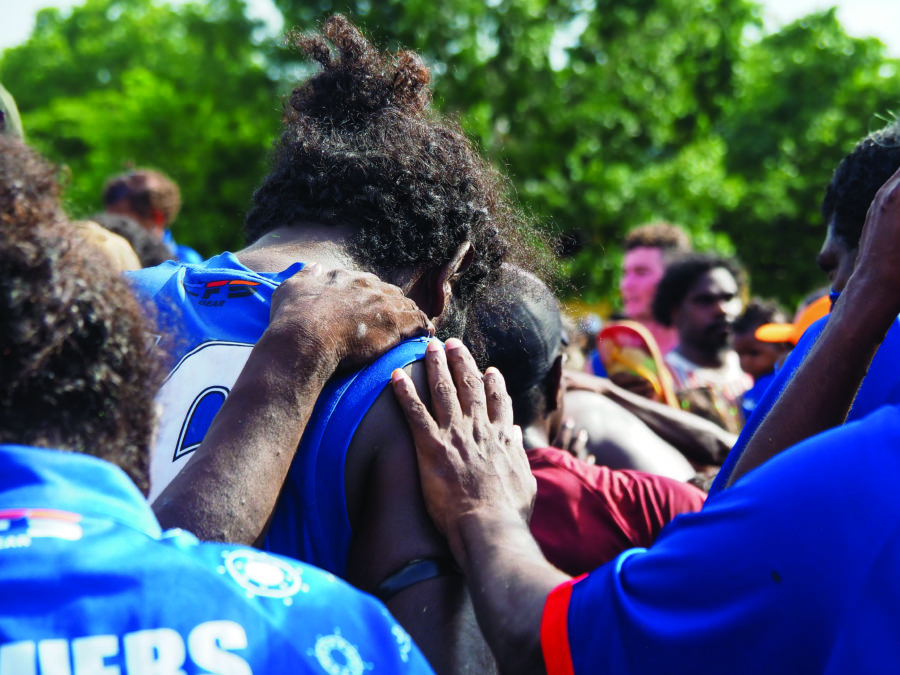
I’m looking through the tiny, dusty window of the small plane carrying our group of four from one side of Bathurst Island to the other. A network of waterways framed by overgrown mangroves between eucalypt forest and dense rainforest forms patterns that resemble the intricate venation of a leaf.
The plane’s engine roars and my heart races as we feel every bump and air pocket with a jolt. The island is just 2600sq.km and it’s only 50km east from our accommodation at Tiwi Island Retreat in the south-west to the main town of Wurrumiyanga, but I feel every bump along the way.
The pit of my stomach starts to churn in a swell of motion sickness and I try to combat it by focusing on the horizon. But the view from my window of the wild landscape below is far too fascinating to disrupt my gaze. I become fixated on the patterns and greenery that seem reminiscent of more far-away and exotic countries than any part of Australia I’ve seen.

We’re heading to the annual grand final of the Tiwi Islands Football League, where home team the Walama Bulldogs is set to take on the Imalu Tigers, who have travelled from Pirlangimpi on the largest of the Tiwis, Melville Island.
Melville and Bathurst are the best known, but there are nine other uninhabited islands in the Tiwi Islands chain, situated in the Timor Sea. A population of 2700 is spread across the archipelago’s 8320sq.km area, with most people living in Wurrumiyanga. More than 90 per cent of the Tiwi population identifies as Aboriginal, living in the other three major communities of Milikapti, Pirlangimpi and Wurrumiyanga, and in the tiny outstations Wurankuwu, Pickataramoor, Paru, Taracumbi, Yimpinari, Takamprimilli, Pitjimirra and Four Mile. The last time I visited Bathurst Island, the airport was nearly deserted, with one man guarding the terminal – a small tin building that looks like not much more than a bus shelter.
It was in stark contrast to the busy runway we’re landing on this time. Our small eight-seater plane steers its way between a sea of aircraft, and I wince when the pilot navigates the wing of our trusty charter inches away from another. The air is thick and humid, but a slight breeze offers welcome relief from the heat of the cabin.
Crowds of tourists wend their way through football groups, clothing layers start to come off and the phrase “It’s so hot!” fills brief moments of silence between the sounds of propellers and a northern goshawk squawking in a nearby tree.

A permit is usually required to travel to the Tiwi Islands, but grand final day is an exception. Once a year, usually in March, the islands are open for people to visit and experience the culture, art and history as busloads of people are shuttled between the airport, football grounds, museum and art centres. It’s a much-anticipated day for all the Tiwi Islanders who travel to Wurrumiyanga from across the region to gather for the spectacle of the grand final and welcome travellers from the mainland to witness the passion and excitement of Tiwi football.
Our bus travels along a dusty red-dirt track towards our first stop – Ngaruwanajirri, the art centre. Tall gum trees shoot from the earth between pandanus and sand palms, with shrubs and grass growing wild at their roots. Puddles sitting in the clay add a sense of drama to the scene, with grey clouds in the distance threatening the clarity of the blue sky.
The grand final weekend is about more than football. It’s an opportunity to showcase the Tiwi Islands culture to the rest of Australia and the world.
“We have people come on the island and experience firsthand football at its best, along with our culture, arts and the community itself,” Brian Tipungwuti, our cultural guide explains.
“We welcome, with open arms, the world to come in and experience football and culture with us. Our culture is different from everyone on the mainland. Our culture is unique…and everything you want to experience on Tiwi Islands you get to experience on this day.” He smiles and adds, “There’s no-one here to bite ya. We’re all just Australians.”
We welcome, with open arms,
Brian Tipungwuti, Tiwi island cultural guide
the world to come in and experience
football and culture with us.
By the time we arrive at the small shed where the art sale is being conducted, the sun is high in the sky beating its rays down on the tin shelter, turning it into a sweaty hot box. Crowds try to navigate the space, bodies pushing past bodies, reaching over shoulders, each fighting for an early pick of the available art. By now, most of the pieces are in the hands of excited buyers or marked with red dots indicating they’re sold.
Colourful banners of screen-printed fabric float down from the elaborate ceiling, which is covered in panels decorated in all sorts of patterns and shades of brown, white, black and red. At the back of the shed, Tiwi artists sit at a table creating their next masterpieces. Canvas and paper artworks are piled high on the tables and in folders, waiting for a new home, while sculptures and ceramic works garnish trestles.
Yellow, red, orange and white lines, dots and arches splash across the various canvases in a display of Tiwi’s signature geometrical patterns. The islands are famed for their artists, all of whom produce pieces that are distinctly different from mainland styles.
It may seem unusual, almost blasphemous in some circles, that football and art merge in a weekend of equal significance. But out here on the Tiwi Islands, both play an important role in the culture.
Art is linked to ancestors, Creation stories and ceremonies. It’s a form of social interaction, self-expression and cultural tradition.
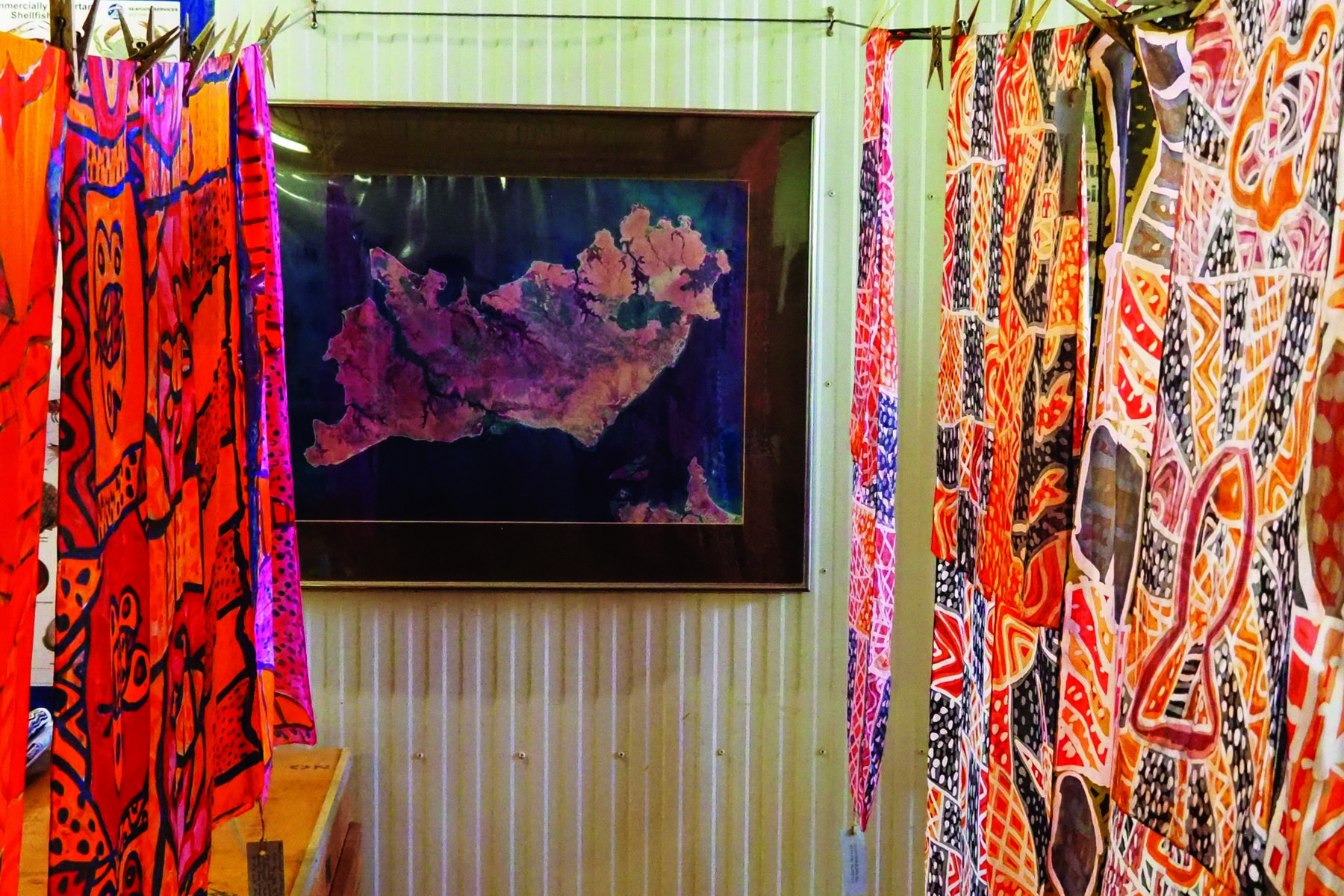
I ask Brian what it is about football that draws so much excitement to the islands. “Footy is like a religion to the Tiwi people,” he says. “It started with the Catholic Mission. The Catholics brought over a bloke by the name of Brother John Pye from Victoria – he was one of the Catholic brothers who started football [here].
“He saw a lot of talent in Tiwi footballers, in people from the Tiwi Islands, so he sent them all into Darwin to St Mary’s Football Club. It started there and just got bigger and bigger.”
Alongside important records of Tiwi Dreamtime, the Catholic Mission and history, the Patakijiyali Museum is well known for having an entire exhibit dedicated to the islands’ sporting heritage, with a particular emphasis on Australian Rules Football.
It may seem unusual, almost blasphemous
in some circles, that football and art merge
in a weekend of equal significance.
But out here on the Tiwi Islands,
both play an important role in the culture.
The Tiwi Football League is the second biggest in the territory, behind the Northern Territory Football League. There are eight clubs, which are loosely based on land groups. “All the teams here on the islands, they all represent their Country. We have eight landowner groups. My team is Ranku Eagles, that’s where I belong. That’s my Country,” Brian explains.
“It’s not just a football thing, it’s the traditional home of our team, our people. Imalu Tigers are from Garden Point (Pirlangimpi) on Melville Island, and that’s what the Country is called – Imalu.” He adds, laughing, “But obviously, we got no tigers.
“That’s what makes it unique, we’re not only playing for our team, we’re playing for our Country also. We’re playing for our ancestors.”
By the time we reach the SeaLink marquee at Wurrumiyanga Oval, my feet have started to absorb the red of the dirt and I look like I’m camouflaged. We make it just in time for the teams to run out onto the field. I stand excitedly by the Bulldogs dugout, waiting for the players’ grand entrance, when a small child breaks away from the crowd and heads towards the change rooms, calling out for his dad. Family and friends fringe the path to the oval beside a large banner that proclaims, “The underdogs are hungry for victory!”
Suddenly, the sound of cheers and encouraging grunts echo from the change rooms and the claps from the crowd become deafening. There are about 1000 people at the oval, and at this moment it feels as if they’re all surrounding me. The child calling out for his dad is swiftly picked up by the man leading the team out to the oval.
It reminds me of the games of football I used to watch when I was a kid – community events, where spectators and players are separated only by guernseys, and a pat on the back replaces sidelined rallies.
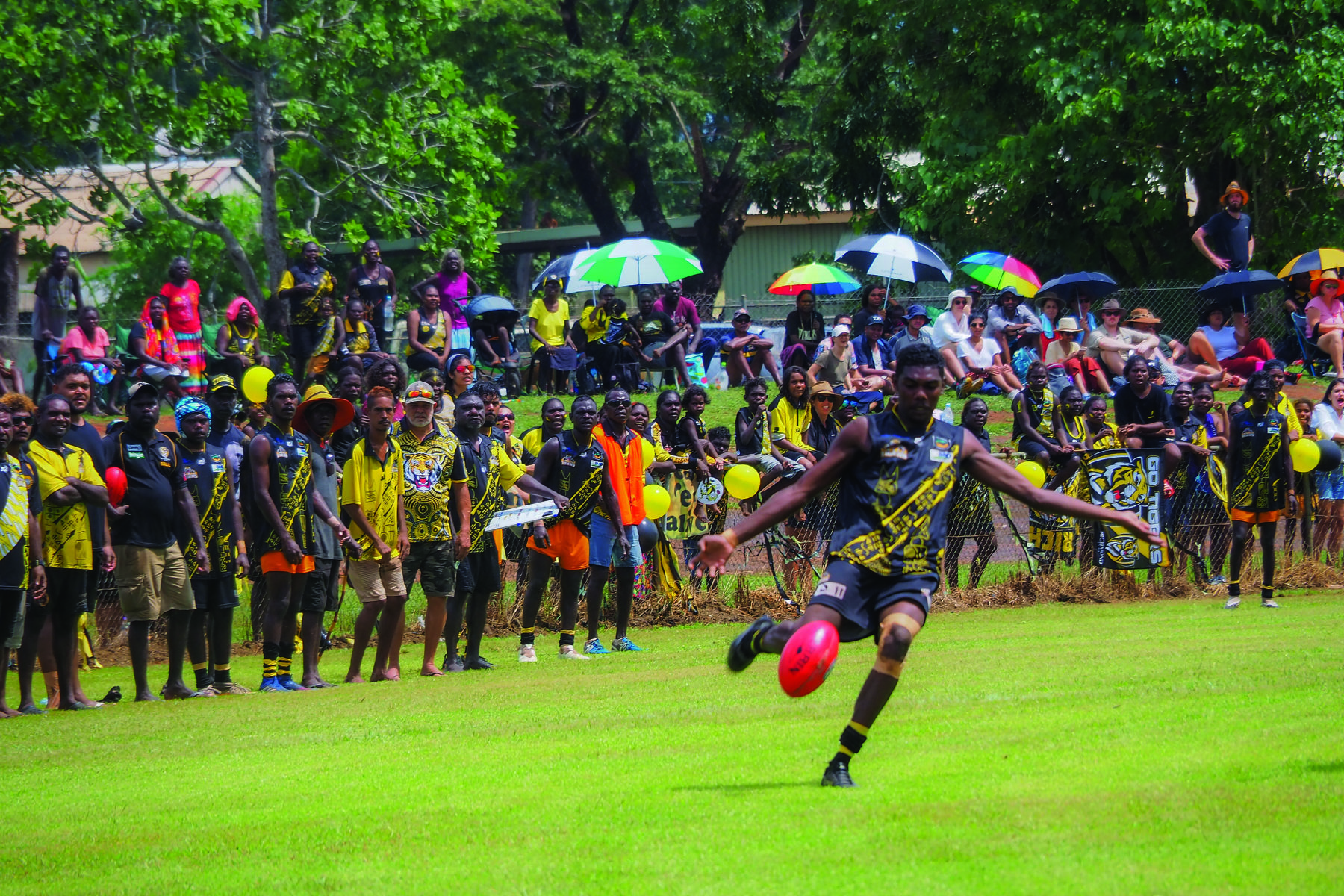
As the players take their positions on the ground, a downpour of rain that has forced most people to run for cover suddenly clears, as if the weather is sounding its own whistle for the game to begin.
I’m so enthralled by the community support coming from the onlookers that I barely watch what’s happening on the field. Groups of people are sitting on the roofs of their cars outside the ground, others sit atop the fence, while kids splash around in puddles and play their own match on the sidelines.
It takes just one and a half minutes for the first goal to be scored by the Bulldogs player wearing the number two guernsey and it sends the crowd into a roar of jubilation. Minutes turn to hours and the rollercoaster of emotions from the sea of yellow and black, and blue, red and white, are mirrored by the on-again, off-again rainstorms.
I’m standing barefoot on the sidelines of the oval. My clothes are soaked through, a combination of sweat and rain. This is common in the Tiwi Islands, bystanders tell me, as they comment on my beige-coloured pants, now covered in specks of orange clay – the result of wading through muddy puddles and kicking the ball around with groups of kids keen to have me join in. They take great joy in jumping in the puddles to watch the muddy water splash over my poor choice of clothing.
The Tiwi Strong Women’s Choir sings a rendition of “Advance Australia Fair” over the speakers while spectators take the opportunity to kick the footy around the oval.
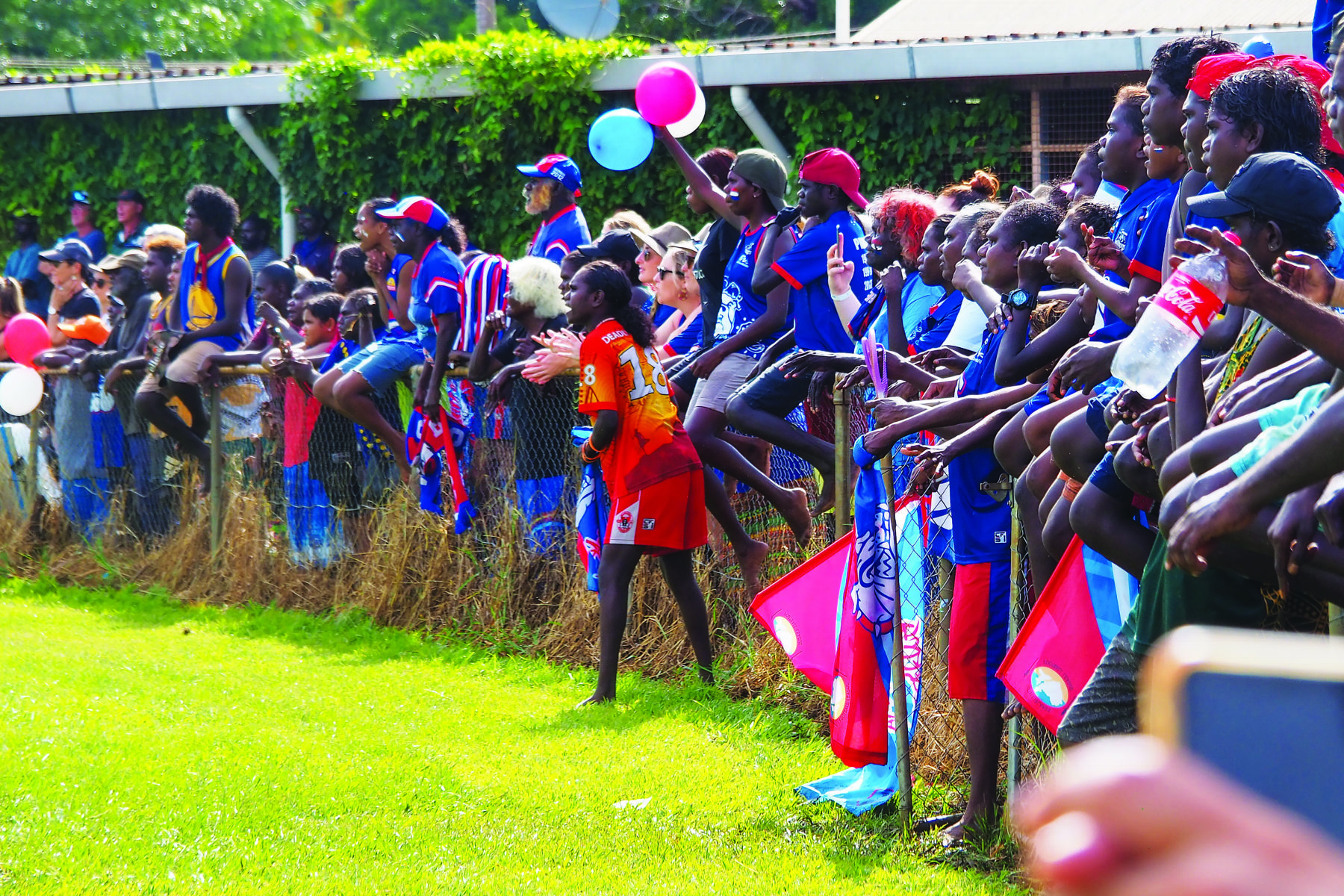
The siren sounds again for the second-last time today, signalling the start of the final quarter. The Bulldogs are up by 10 points – the margin tightened after a Tigers player kicked a goal on the three-quarter-time whistle.
There are just minutes left on the timer when the Bulldogs add another six points to the score. Before the siren has a chance to sound, people are making their way onto the oval. A cry rings from the speakers and the crowd erupts in a roar of excitement.
A throng of Bulldogs supporters run onto the field in a type of celebration I’ve not seen before. I’m caught up in the emotion of it all as I watch grown men weeping with joy, comforted by family members who wipe watery eyes. It’s a real display of community, family and kinship. Children run into their fathers’ arms. A group of women in the middle of the pack break out into dance, flags waving animatedly in celebration.
As I board the SeaLink ferry to Darwin, masses of people stand on the shores of Apsley Strait that runs between the islands. Boats dart back and forth, ferrying people less than 1km. The Bulldogs supporters are audibly elated, but it’s the smiles of the Tigers fans that really stand out for me.
Australian Rules Football isn’t just a game here. It’s part of the fabric of the culture. And at the end of the day, despite rivalries and competition, football is as much about community as it is the numbers on a scoreboard. On the Tiwi Islands, football is truly more than a game.
